Japan
Wood Products Prices
Dollar Exchange Rates of 10th
August
2020
Japan Yen 106.49
Reports From Japan
¡®Pandemic fatigue¡¯ setting in
A second wave of corona virus cases in Japan¡¯s major
cities is a threat to the initial signs of economic recovery
but the government is hesitating to request businesses to
again suspend operations hoping the regular news on
infections would encourage residents to continue with
their efforts to reign in the spread.
The problem is that now there is a growing ¡®pandemic
fatigue¡¯ setting in especially among the younger
generation who make up most of the new cases of
infections.
The Ministry of Finance has painted an optimistic picture
for all regions in the country saying consumer spending
and production appears to be bottoming-out. The ministry
also revised its overall assessment of the Japanese
economy saying that there are signs of recovery in some
areas.
See:
https://www.nippon.com/en/news/yjj2020080400539/japanmof-revises-up-economic-views-for-all-regions.html
Lending support to the suggestion that the economic
downturn is bottoming-out an index reflecting the current
state of the Japanese economy improved in June for the
first time in five months. The Cabinet Office preliminary
data for business conditions in June showed an uptick.
But, the Cabinet Office maintained its assessment that the
Japanese economy is "worsening," using the most
pessimistic expression for the 11th straight month.
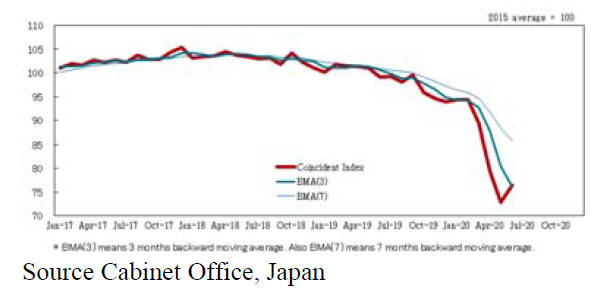
Pace of decline in spending slows
Data from the Ministry of Internal Affairs is suggesting
that June household spending, while still dipping down,
fell at a much slower pace than in May when spending
dropped over 16%.
The 1% decline in June marks the ninth consecutive
decline. The Ministry data shows spending on tours and
theater admissions were down more than 90%. In contrast,
purchases of household furniture and electrical goods
almost doubled compared to May. A ministry
spokesperson said the government's yen 100,000 payout to
all residents helped slow the decline in spending.
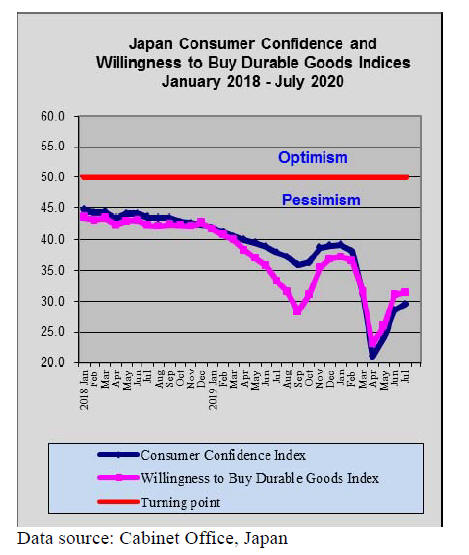
Yen/dollar exchange rate change losses steam
The Japanese yen gained against the US dollar towards the
end of July but by mid-August had weakened again to
around the 106/7 yen to the dollar. A weaker yen is good
news for exporters but it appears the yen is set to
strengthen given the increased uncertainty on many
economic fronts.
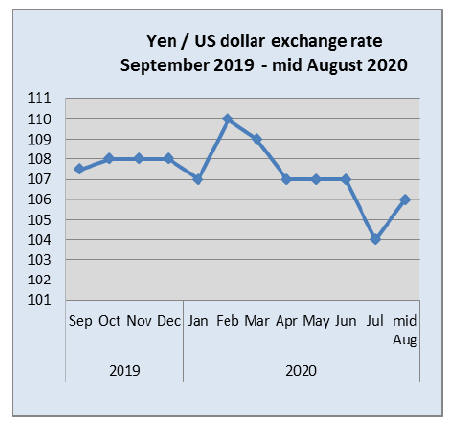
Uptick in orders for new homes
The Japan Lumber Reports has assessed demand for
housing and reports major builders have seen a slight
recovery. Sales by major builders in June were higher than
May.

Japan/UK trade deal close
Japan and the UK have been discussing a free trade
agreement to come into effect when the UK leaves the EU.
The Japanese media has reported that agreement has been
reached on tariffs covering almost all industrial products
and on digital, data and financial services that go beyond
the EU-Japan arrangement. Japanese government has said
the remaining issues are limited to some agricultural
products.
See:
https://www3.nhk.or.jp/nhkworld/en/news/20200808_05/
Import update
Furniture imports
There has been a noticeable downward trend in imports of
wooden kitchen furniture (HS940340) that appears to have
started in October last year. In the seven months to May
2020 in only two months have there been month on month
increases in the value of imports.
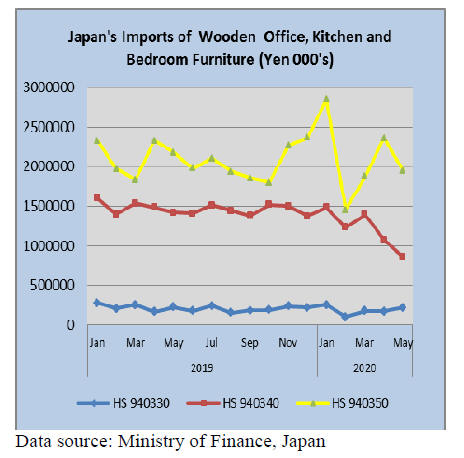
Office furniture imports (HS 940330)
The value of May imports of wooden office furniture
(HS940330) was down around 3% year on year but
compared to April the value of imports rose 24%.
Most wooden office furniture imports originate in China
(74% of the May total) and in May the other main shippers
were Portugal and Poland. Shippers in China saw May
exports to Japan rise 15% and shippers in Portugal and
Poland also saw a sharp increase in office furniture exports
to Japan.

Kitchen furniture imports (HS 940340)
Year on year Japan¡¯s imports of wooden kitchen furniture
have fallen around 40% and the value of May imports
were some 20% below that in April.
Each of the three main shippers saw declining exports of
wooden kitchen furniture in May. Exports in May from
Vietnam, now the main supplier, were down by almost
half compared to April and Japan¡¯s imports of wooden
kitchen furniture from China dropped 15% in May.
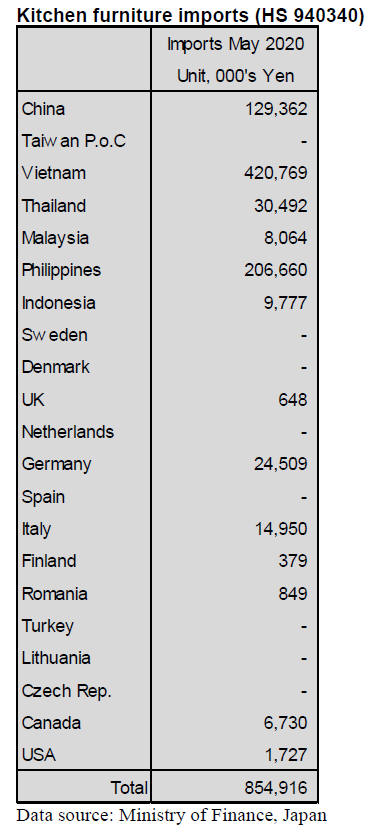
Bedroom furniture imports (HS 940350)
After the steep decline in the value of wooden bedroom
furniture in February there has been two consecutive
months of increases bring the average value for a three
month period back to usual levels.
However, May imports of wooden bedroom furniture
slipped into negative territory once again dropping 17%
month on month. Year on year, imports of HS(940350)
were down 10% in May this year.
Shippers in China and Vietnam dominate Japan¡¯s imports
of wooden bedroom furniture with China accounting for
around 60% of all wooden bedroom furniture imports with
another 30% plus coming from Vietnam. Exporters in
Thailand (the 3rd largest shipper in May) accounted for
just 3% of all wooden bedroom furniture imports.

Trade news from the Japan Lumber Reports (JLR)
The Japan Lumber Reports (JLR), a subscription trade
journal published every two weeks in English, is
generously allowing the ITTO Tropical Timber Market
Report to reproduce news on the Japanese market
precisely as it appears in the JLR.
For the JLR report please see:
https://jfpj.jp/japan_lumber_reports/
Wood demand projection meeting
The Forestry Agency held wood demand projection
meeting on June 29 for the second half of 2020. In wood
demand in 2020, domestic logs would decrease by 11.9%
from 2019. Imported logs would drop by 15.3%. Imported
lumber would decline by 12.3%.
Forecast for new housing starts in 2020 by private think
tanks would drop much more than the forecast made in
last March.
In total of 12 think tanks, only two predicted less than
800,000 units in last March forecast then this time, five
out of ten forecast drop of less than 800,000 units.
Average starts would be 788,000 units from 847,000 units
in March.
In previous forecast, the reason of decline was
consumption tax hike then coronavirus outbreak is added
another declining factor. Actually two think tanks forecast
starts of less than 750,000.
For domestic logs in 2020, logs for lumber would decrease
by 14.4% and for plywood would drop by 5.0%.
Paper and pulp manufacturing plants restrict purchased of
logs by rapid decline of use of paper for office use and
others like flyers. Log export business for China and other
countries is hard to forecast, particularly for China because
of trade conflict with the U.S.A. despite of the fact that
lumber production in China is rapidly recovering.
In imported lumber, North American lumber would
decrease by 17.8% not by supply side problem but by
dropping domestic demand. European lumber supply
deceased by supply side problem in the first half of 2020
then the demand would decrease in the second half of the
year. Forecast of demand in 2020 would be down by 8.3%.
Radiata pine lumber supply from New Zealand and Chile
in the second quarter this year is 55.6% less than the same
period of last year. The supply seems to increase in the
second half to the same as last year.
Russian lumber inventory in Japan increased during the
second quarter by active supply in the first quarter. The
supply would decrease in the second half of the year but
the demand is also dropping so heavy inventory seems to
continue through the year.
Import of legally certified wood products
The Japan Lumber Importers Association held general
meeting on June 19. It reports that total import of logs and
lumber in 2019 was 8,840,000 cbms, 5.7% less than 2018.
This is three consecutive years¡¯ decline and wood demand
is related to new housing starts, which have been
declining.
It forecasts that the demand would continue decreasing
particularly by coronavirus outbreak in 2020. However, it
continues to advise importing of legally certified wood
products.
Import of legally certified wood products in 2019 by 60
members of the Association was 73.5%, 0.6 points less
than 2018.Percentage of sales with the certificate were
33.7%, 4.4 points less, which is 24.7% in total imported
volume. This is 3.5 points less than 2018 and trend seems
to keep declining.
The Association reports that it is not because of negligence
of the members but because of the fact that about one
fourth of products is unable to obtain legality certificate so
the Association reports that any more increase of the
percentage seems impossible.
Also the Association reports that the share of imported
wood by the members is 53% in total imported volume.
South Sea (tropical) logs and lumber
Supply and demand of South Sea hardwood logs are
balanced and users carry about two to three months
inventory as the consumption is dropping by slower
demand by corona virus incident.
The largest log consuming plywood mill in Japan will be
out of business in March 2012 so it may need another log
ship before closing but log demand will keep dropping.
Inventory of free board of Chinese red pine and
Indonesian mercusii pine is adequate. The demand in
Japan is dropping so the orders from Japan are decreasing.
Recovering housing orders
Orders for house builders, which specialize in order-made
houses were recovering in June.
Order values for eight major builders in June was 15% less
than June last year. It was about 35% less for April and
May so house buyers who stayed at home during March
and May started going out in June.
Number of visitors to house exhibition sites by large house
builders has not recovered enough yet. Meantime, low cost
house builders and builders for units built for sale attract
more buyers since negotiations are shorter.
Sales value by eight major builders (Sekisui House, Daiwa
House, Sekisui Chemical house, Panasonic Homes,
Misawa Homes, Sumitomo Forestry, Asahi Kasei Homes,
Mitsui Home ) in June is higher than May.
They report that reaction of buyers is getting better week
after week but fear of second wave of corona virus is
concern and large sales promotional events are not
allowed yet so there is no blind optimism.
Major builders are also concerned to competition with low
cost builders despite different class of buying people. Low
cost builders had more orders during March and May
when major¡¯s activities were almost dead.
Weakening softwood plywood market
In Tokyo market, softwood plywood (12 mm/3x6) prices
are down to 900 yen per sheet delivered, lowest in about
four years. The prices have been softening since last May
and wholesalers comment that price skidding in last one
month is much faster than the Lehman shock days.
In weak demand, June was quarter end book closing
month and sales competition got fierce and price war
started.
Looking at rapid price decline in June, dealers saw bearish
future and reduces the purchase and precutting plants¡¯
consumption is also decreasing.
Plywood manufacturers plan to reduce the production in
August by 30% to stop rapid skidding of the prices. With
such strong attitude of the manufacturers, the market
finally settled down now temporarily.
Imported plywood market
In South Sea hardwood plywood, market prices of 12mm
coated concrete forming panel are down by 20-30 yen per
sheet down from June. Due to uncertain future market,
dealers are trying to dispose of the inventory as fast as
possible and offered low prices.
There is warning of supply shortage after July but there is
opposite opinion so the prices are highly fluid.
Prices of 12 mm panels turned soft after the State of
Emergency was lifted in May. The prices were rather firm
before that as fear of supply from Malaysia by corona
virus epidemic so dealers tries to sell the inventory
cautiously but with uncertainty of future demand, they are
trying to move the inventory to get cash so the market
prices turned weak.
The importers did not place any future orders since last
April so the arrivals continue low.
Warehouse management in Tokyo Bay reports that the
arrivals have started declining sharply since June. The
importers should place large orders now but supplying
mills have been curtailing the production so the mills need
to start buying logs to deal with larger orders and the
proposed export prices should be higher.
There are two opposite forecasts. One is supply shortage
in coming months and another is no shortage because of
stagnant demand. It is like groping in the dark by hands.
Thus, sales attitude differs. Some keep selling as fast as
possible while the others are cautiously selling so the
market prices are hard to pin point.
Present market prices of JAS 3x6 concrete forming panel
for coating are 1,290 yen per sheet delivered, 20 yen down
from June. Prices of JAS green concrete forming panel are
about 1,220 yen and of 3x6 structural panel are about
1,230 yen. Both are 20 yen down from June.
Trend of imported logs for manufacturing plywood in
Japan
Declining trend of imported logs for manufacturing
plywood continues. There are various reasons by
supplying countries. Log export ban by state of Sabah,
Malaysia, increase of log export duty by PNG, increase of
log export duty in Russia and harvest disruption by B.C.,
Canada¡¯s major log supplier but there is very little impact
to plywood manufacturing industry in Japan, which has
been shifting to use domestic logs and by current
production curtailment for shrinking demand by corona
virus epidemic.
In North America, Mosaic Forest Management, the largest
log export log supplier in B.C. Canada, stopped log
harvest since last November so log import form Canada
drastically dropped by 76.6% during January and May.
Supply of Russian Far East larch log has been decreasing
after increase of log export duty started last year. For the
first five month, total supply was only 14,611 cbms,
51.9% less than the same period of last year.
Export prices are US$190 per cbm C&F, which are higher
than Canadian Douglas fir logs. There should be more
demand when the North American Douglas fir log supply
decreases but the inquiries are declining by weak demand
of plywood in Japan.
The reason is plywood manufacturers¡¯ production
curtailment. They have been reducing the production since
last February by 20-30% so log demand drops that much.
Demand for domestic logs is the same. In other words,
domestic log supply is ample to supplement shortage of
imported logs.
South Sea log import for the first five months is 44,836
cbms, 24.9% less than the same period of last year.
South Sea log supply situation has deteriorated rapidly in
last two years. Supply of South Sea hardwood logs has
been decreasing and the volume in 2017 was less than
150,000 cbms. In these days, 48.5% was Sabah logs.
After Sabah, Malaysia banned log export in May 2018, the
demand shifted to PNG, which increased log export duty
since last February. Sabah supply was almost 50% for
Japan market and after Sabah, stopped log export, hope of
stable supply of South Sea hardwood logs was gone.
PNG log supply in 2017 was only 19.7% in 2017 then
fortunately main PNG log buyer of China retreated
because of trade war with the U.S.A. so that Japan could
get in and replace Sabah supply so in 2019, PNG logs took
76.1% share of total import of South Sea logs. Then in
February 2020, PNG government raised log export duty
then the government commented to reduce log export
volume by half by 2025 and total ban in 2030.
Under this situation of supplying countries, the largest
plywood manufacturer of South Sea hardwood logs,
Daishin Plywood in Niigata announced to withdraw from
the business in March 2021. It consumes about 80,000
cbms a year, about 60% of total imported volume of South
Sea logs.
The reason is obvious that future supply of South Sea
hardwood logs is ambiguous. PNG replaced Sabah but
there is no other supply source to replace PNG.
Canadian Douglas fir log prices soared to US$150 per cbm
FAS from US$110 when North American lumber market
in 2017 and 2018.
Imported cost was about 24,000 yen per cbm FOB truck
port yard then FAS prices dropped down to US$135 in
2019 but the cost remained over 20,000 yen. It is not
competitive with domestic larch logs, which is about
17,000 yen.
Demand for Douglas fir logs was strong because 12 meter
length and high strength but now the cost of domestic logs
is lower than Douglas fir logs even with premium for long
length cutting in Japan.
The Russian government has been promoting wood
processing in the Russian Far East region and log export
duty has been raised step by step, which reduced supply of
larch logs for plywood manufacturing in Japan. The duty
was 25% until 2018 then increased to 40% in 2019 and
60% in 2020.
The import of Russian larch logs in 2018 was about
102,000 cbms, in 2019 was about 77,000 cbms, 25.2% less
than 2018. First five months import in 2020 is about
14,600 cbms, 52% less. High export duty is prohibitively
high so that many larch log exporters quit in 2019. Export
prices of Russian larch are about US$190 per cbm C&F,
which costs over 20,000 yen per cbm so again like
Canadian Douglas fir logs, the prices are not competitive
with domestic larch logs.
Larch veneer is another major export item from coastal
Russia. The supply needs to be adjusted to reduced
production of Japanese plywood mills but larch veneer
helps simplify plywood processing at the mills and it can
be used for face and back to guarantee enough strength so
it is valuable material for plywood mills.
According to the wood statistics, logs supplied for
plywood manufacturing are 5,448,000 cbms in which
share of imported logs is 12.9%. In 2015, the volume was
4,218,000 cbms in which share of imported logs was
20.5% so in four years, share of imported logs decreased.
Reasons that domestic plywood manufacturers look for
domestic logs for plywood manufacturing are long term
supply stability and no risk of exchange rate, which
changes cost of logs from time to time. Domestic larch and
cypress are higher in cost compared to cedar but lower
than imported species.
Long plywood used to need imported long length logs but
now log harvesters in Japan have started supplying long
length logs as the demand by plywood mills increases so
now long plywood with 100% domestic species are being
supplied. When plywood mills curtail the production, the
mills are aware that supply of domestic logs is necessary
in long term so that they reduce inventory of imported logs
and give domestic logs priority.
Demand of imported logs for plywood seems to keep
decreasing by reasons of supplying countries and
availability of domestic logs in Japan.
|